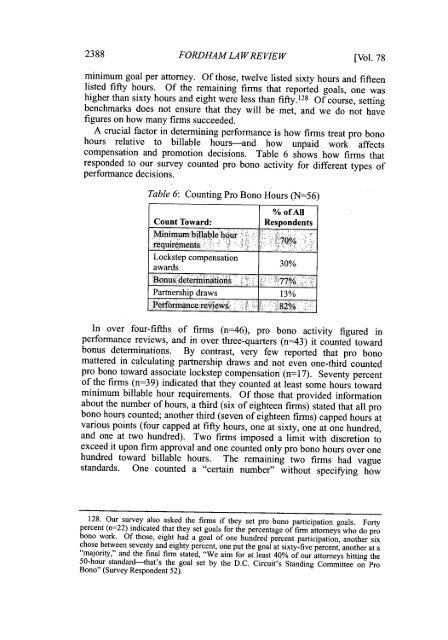Law for The Poor
Law for The Poor
Law for The Poor
Create successful ePaper yourself
Turn your PDF publications into a flip-book with our unique Google optimized e-Paper software.
2388<br />
FORDHAM LAW REVIEW<br />
[Vol. 78<br />
minimum goal per attorney. Of those, twelve listed sixty hours and fifteen<br />
listed fifty hours. Of the remaining firms that reported goals, one was<br />
higher than sixty hours and eight were less than fifty. 1 28 Of course, setting<br />
benchmarks does not ensure that they will be met, and we do not have<br />
figures on how many firms succeeded.<br />
A crucial factor in determining per<strong>for</strong>mance is how firms treat pro bono<br />
hours relative to billable hours-and how unpaid work affects<br />
compensation and promotion decisions. Table 6 shows how firms that<br />
responded to our survey counted pro bono activity <strong>for</strong> different types of<br />
per<strong>for</strong>mance decisions.<br />
Table 6: Counting Pro Bono Hours (N=56)<br />
% of All<br />
Count Toward:<br />
Respondents<br />
Minimum billable hour 70%<br />
requirements<br />
Lockstep compensation 30%<br />
awards<br />
Bonus determinations 77%<br />
Partnership draws 13%<br />
Per<strong>for</strong>mance reviews 82%<br />
In over four-fifths of firms (n=46), pro bono activity figured in<br />
per<strong>for</strong>mance reviews, and in over three-quarters (n=43) it counted toward<br />
bonus determinations. By contrast, very few reported that pro bono<br />
mattered in calculating partnership draws and not even one-third counted<br />
pro bono toward associate lockstep compensation (n=17). Seventy percent<br />
of the firms (n=39) indicated that they counted at least some hours toward<br />
minimum billable hour requirements. Of those that provided in<strong>for</strong>mation<br />
about the number of hours, a third (six of eighteen firms) stated that all pro<br />
bono hours counted; another third (seven of eighteen firms) capped hours at<br />
various points (four capped at fifty hours, one at sixty, one at one hundred,<br />
and one at two hundred). Two firms imposed a limit with discretion to<br />
exceed it upon firm approval and one counted only pro bono hours over one<br />
hundred toward billable hours. <strong>The</strong> remaining two firms had vague<br />
standards. One counted a "certain number" without specifying how<br />
128. Our survey also asked the firms if they set pro bono participation goals. Forty<br />
percent (n=22) indicated that they set goals <strong>for</strong> the percentage of firm attorneys who do pro<br />
bono work. Of those, eight had a goal of one hundred percent participation, another six<br />
chose between seventy and eighty percent, one put the goal at sixty-five percent, another at a<br />
"majority," and the final firm stated, "We aim <strong>for</strong> at least 40% of our attorneys hitting the<br />
50-hour standard--that's the goal set by the D.C. Circuit's Standing Committee on Pro<br />
Bono" (Survey Respondent 52).

















